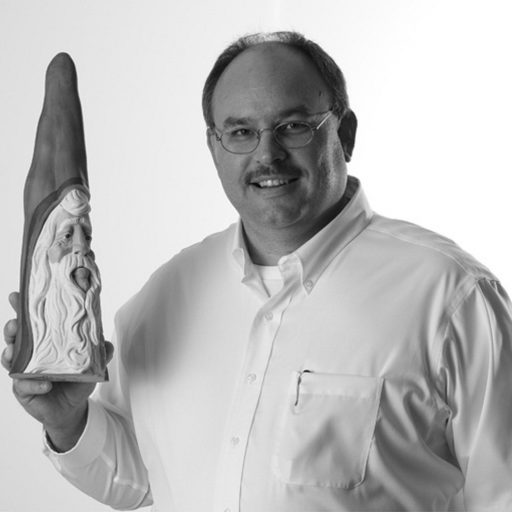My Carving Journey
As my father approached his retirement date, we had discussions on woodworking being an activity that we could do together. I had been working on my scroll saw projects, but the scroll saw did not have the same appeal for my father. The scroll saw’s versatility and ability to assist with carving projects eventually won my father over and he enjoys the scroll saw now as well.
A woodworking show came into our hometown, and while looking at the demonstrators and topics that would be presented, we selected a carving lesson and demonstration which we thought would be fun and informative. The demonstration covered basic carving tools, safety, how to make some basic cuts and highlighted a few simple projects. My father and I immediately were struck by the presenter and his easy manner and patient approach in answering our endless amount of questions. Jerry Edwards was the presenter that day, and as I have stated on other pages, we had stumbled upon a very valuable resource, and a very generous human being. Jerry stayed after the presentation and allowed my father and I to pick his brain and to also explore the tools he had brought. We were hooked, and woodcarving became the woodworking discipline my father and I would embark along and explore together.
Like many of the other woodworking disciplines that are on this site, we had a great resource to direct us and now we had to dig in and get started. Buying some basic tools and some safety equipment were first and foremost on our list of things to start. Jerry patiently guided us out to the vendors at the wood show and in less than an hour, we had a basic Murphy knife, a Kevlar glove, a leather thumb guard, a leather knife strop, some sharpening compound, some blocks of basswood and some pattern books for inspiration. I had purchased tools and machines for my other woodworking activities and was shocked at how little money had to be invested to get started in carving. All told, without the pattern books, my father and I had spent less than $30 each for our basic equipment. Now do not get me wrong, there are plenty of expensive machines, knives, tools and wood that can be purchased for carving, but for a basic set $30 to $50 is all you will need to get started.
With our new tools, some wood blanks and a good helping of beginner enthusiasm we embarked upon our carving journey! We started again in the enthusiastic beginner phase, where we were reading and applying all of the instruction and advice we had soaked up during our time at the wood show. Carving is hard work for a beginner. The hand strength and muscle memory are a few of the items that shock a first time carver. Holding a block of wood, pushing or pulling a knife through that wood and concentrating on making good cuts safely will take a lot out of a beginner carver. Blades get dull, hands get tired and a simple boot carving starts to look like a full scale Michelangelo Pieta carving. Blisters start to form, hands become sore with hopefully no cuts being accumulated and frustration starts to creep in to your carving sessions. Valuable lessons are learned at the beginning, most of them what not to do! [See the FAQ Section].
With the basics skills being practiced and honed, the focus now became carving more complex patterns and using different woods and tools. Here is where some serious money can be spent buying specialty hand tools, machines and bits for rotary tools [See the FAQ Section].
Once again my father and I relied on the woodworking collective borg in our town. We visited a woodcarving club and joined as members the very first night. We had access to some of the best wood carvers in the Southeast. The scope of the work and the mastery of so many techniques in the club was impressive from the very first visit with the club. If we could soak up even 10% of the advice and talent shown by the group we would have considered ourselves very fortunate indeed!
Each woodcarving club is unique and we were very fortunate that our new club had a carving project every single monthly meeting. We had talented carvers present a carving project, we had blanks provided and expert tutelage on how to accomplish the monthly project. These simple projects were the singular reason that our carving skills and techniques progressed so rapidly. [See the FAQ Section]. Having a project to do with an instructor and other club members to support you during the project was indispensable.
